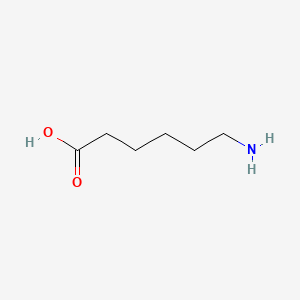| MeSH term | MeSH ID | Detail |
|---|---|---|
| Hemolysis | D006461 | 131 associated lipids |
| Uremia | D014511 | 33 associated lipids |
| Stomach Ulcer | D013276 | 75 associated lipids |
| Diabetes Mellitus | D003920 | 90 associated lipids |
| Sarcoma, Experimental | D012513 | 13 associated lipids |
| Adenocarcinoma | D000230 | 166 associated lipids |
| Lupus Erythematosus, Systemic | D008180 | 43 associated lipids |
| Hyperglycemia | D006943 | 21 associated lipids |
| Wounds and Injuries | D014947 | 20 associated lipids |
| Kidney Neoplasms | D007680 | 29 associated lipids |
6-aminohexanoic acid
6-aminohexanoic acid is a lipid of Fatty Acyls (FA) class. 6-aminohexanoic acid is associated with abnormalities such as Blood Clot, Myocardial Infarction, Cerebrovascular accident, Renal impairment and Scoliosis, unspecified. The involved functions are known as Fibrinolysis, Agent, Hemorrhage, plasminogen activation and inhibitors. 6-aminohexanoic acid often locates in Chest, Blood, Body tissue, peritoneal and Plasma membrane. The associated genes with 6-aminohexanoic acid are P4HTM gene, BSND gene, MTPN gene, NDUFS4 gene and Homologous Gene. The related lipids are Phosphatidylserines and Butyric Acid.
Cross Reference
Introduction
To understand associated biological information of 6-aminohexanoic acid, we collected biological information of abnormalities, associated pathways, cellular/molecular locations, biological functions, related genes/proteins, lipids and common seen animal/experimental models with organized paragraphs from literatures.
What diseases are associated with 6-aminohexanoic acid?
6-aminohexanoic acid is suspected in Cerebrovascular accident, Blood Clot, Myocardial Infarction, Renal impairment, Thromboembolism, Postoperative myocardial infarction and other diseases in descending order of the highest number of associated sentences.
Related references are mostly published in these journals:
| Disease | Cross reference | Weighted score | Related literature |
|---|
Possible diseases from mapped MeSH terms on references
We collected disease MeSH terms mapped to the references associated with 6-aminohexanoic acid
PubChem Associated disorders and diseases
What pathways are associated with 6-aminohexanoic acid
There are no associated biomedical information in the current reference collection.
PubChem Biomolecular Interactions and Pathways
Link to PubChem Biomolecular Interactions and PathwaysWhat cellular locations are associated with 6-aminohexanoic acid?
Visualization in cellular structure
Associated locations are in red color. Not associated locations are in black.
Related references are published most in these journals:
| Location | Cross reference | Weighted score | Related literatures |
|---|
What functions are associated with 6-aminohexanoic acid?
Related references are published most in these journals:
| Function | Cross reference | Weighted score | Related literatures |
|---|
What lipids are associated with 6-aminohexanoic acid?
Related references are published most in these journals:
| Lipid concept | Cross reference | Weighted score | Related literatures |
|---|
What genes are associated with 6-aminohexanoic acid?
Related references are published most in these journals:
| Gene | Cross reference | Weighted score | Related literatures |
|---|
What common seen animal models are associated with 6-aminohexanoic acid?
There are no associated biomedical information in the current reference collection.
NCBI Entrez Crosslinks
All references with 6-aminohexanoic acid
Download all related citations| Authors | Title | Published | Journal | PubMed Link |
|---|---|---|---|---|
| Yang P et al. | Role of PDGF-D and PDGFR-β in neuroinflammation in experimental ICH mice model. | 2016 | Exp. Neurol. | pmid:27302678 |
| Wan N et al. | Preparation, Physicochemical Properties, and Transfection Activities of Tartaric Acid-Based Cationic Lipids as Effective Nonviral Gene Delivery Vectors. | 2016 | Biol. Pharm. Bull. | pmid:27118165 |
| Estcourt LJ et al. | Antifibrinolytics (lysine analogues) for the prevention of bleeding in people with haematological disorders. | 2016 | Cochrane Database Syst Rev | pmid:26978005 |
| Weyand AC et al. | The Role of Platelets and ε-Aminocaproic Acid in Arthrogryposis, Renal Dysfunction, and Cholestasis (ARC) Syndrome Associated Hemorrhage. | 2016 | Pediatr Blood Cancer | pmid:26505894 |
| Choudhuri P and Biswas BK | Intraoperative Use of Epsilon Amino Caproic Acid and Tranexamic Acid in Surgeries Performed Under Cardiopulmonary Bypass: a Comparative Study To Assess Their Impact On Reopening Due To Postoperative Bleeding. | 2015 | Ethiop J Health Sci | pmid:26633931 |
| Zhou H et al. | Algorithmic co-optimization of genetic constructs and growth conditions: application to 6-ACA, a potential nylon-6 precursor. | 2015 | Nucleic Acids Res. | pmid:26519464 |
| Lu J et al. | Epsilon aminocaproic acid reduces blood transfusion and improves the coagulation test after pediatric open-heart surgery: a meta-analysis of 5 clinical trials. | 2015 | Int J Clin Exp Pathol | pmid:26339364 |
| Park M et al. | Evaluation of a specific diagnostic marker for rheumatoid arthritis based on cyclic citrullinated peptide. | 2015 | J Pharm Biomed Anal | pmid:26177216 |
| Ford PA et al. | Autologous Stem-Cell Transplantation Without Hematopoietic Support for the Treatment of Hematologic Malignancies in Jehovah's Witnesses. | 2015 | J. Clin. Oncol. | pmid:25870085 |
| Eaton MP et al. | Pharmacokinetics of ε-Aminocaproic Acid in Neonates Undergoing Cardiac Surgery with Cardiopulmonary Bypass. | 2015 | Anesthesiology | pmid:25723765 |
